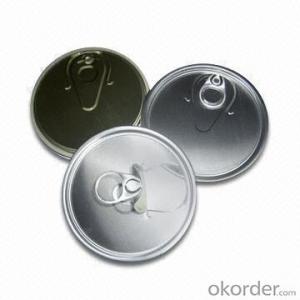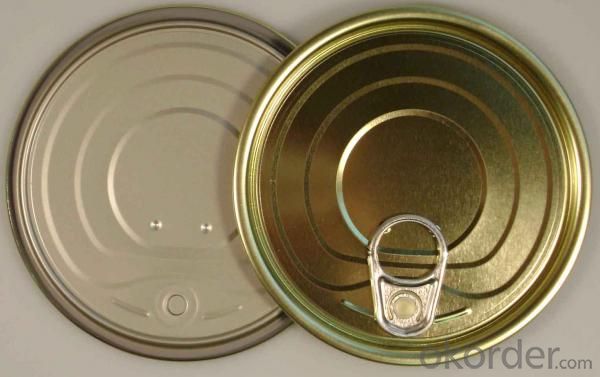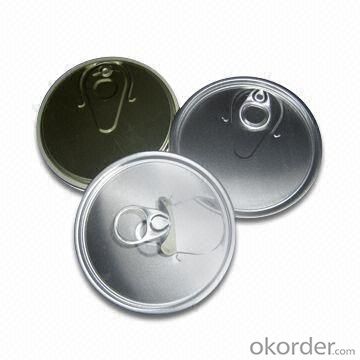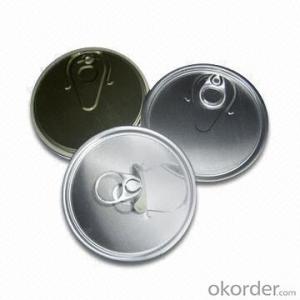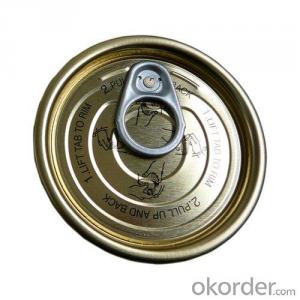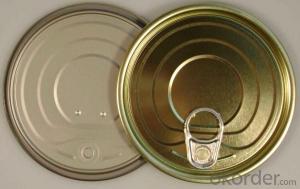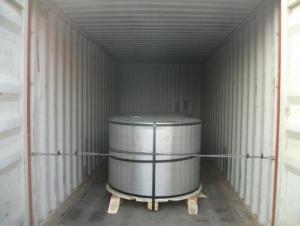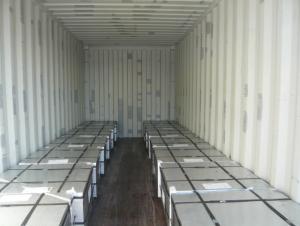Easy Open End, Tinplate And Aluminum Material, Best Quality
- Loading Port:
- China main port
- Payment Terms:
- TT OR LC
- Min Order Qty:
- 100000 pc
- Supply Capability:
- 10000000 pc/month
OKorder Service Pledge
OKorder Financial Service
You Might Also Like
Brief Details
tuna fish can
1.Tinplate 401#
2.Dia:98.9mm
3.Full open
Specifications
Name | tuna fish can |
Item No. | 401# |
Shape/type | Round |
Size(mm) | Dia 98.9 |
Coating | White porcelain |
Material | Tinplate |
Pcs/20 GP’ | 950,000 Customize packing: as clients’ requests. |
Features | 1.Used for packaging of tomato paste,jam,salad…etc. 2.Have illustration printing on the lid. 3.Coating can be according to the customer required. |
Our Workshop
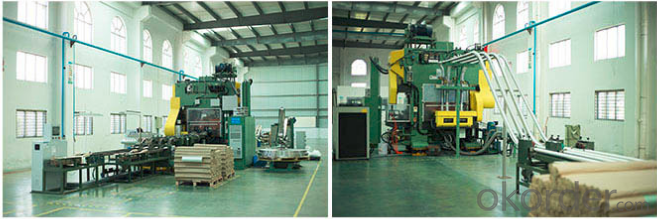

FAQ
1.Q: What is the material and monthly output of EOE?
We can offer both tinplate and aluminum material made EOE, our output reaches more than 1000000000pcs per month.
2.Q:Could you offer samples for our testing?
YES, we could offer sample, but we hope you send us testing report at early time;
3. Q:Can you make new mold with customized size?
YES, We can make new mold for our cutomer, if the qty reach our requirement.
4.Q. Could you give me more information about your company?
Yes, We are one largest state owned company in China, also we are Fortune Global 500 company in the world, our company reputation is good.
5.Q. Which payment term you accept?
We could accept TT, LC at sight, DP, LC after sight etc.
- Q: What are the chemical resistance properties of tinplate?
- Tinplate exhibits excellent chemical resistance properties, as it is not easily corroded or affected by various chemicals. Its protective tin coating provides a barrier against substances that could potentially cause damage. However, prolonged exposure to highly acidic or alkaline solutions may lead to some degradation of the tin coating and potential reaction with the underlying steel substrate.
- Q: How does tinplate compare to paperboard in terms of packaging applications?
- Tinplate and paperboard have different characteristics that make them suitable for different packaging applications. Tinplate is a durable and corrosion-resistant material that is commonly used for packaging products that require protection from moisture, air, and light, such as canned food and beverages. It offers excellent barrier properties and can be easily shaped into various forms, making it ideal for products that require a tight seal. On the other hand, paperboard is a versatile and cost-effective option for packaging applications. It is lightweight, recyclable, and biodegradable, making it environmentally friendly. Paperboard is commonly used for packaging dry goods, such as cereal boxes, cosmetics, and pharmaceuticals. It provides good printing capabilities, allowing for attractive and informative designs. In summary, tinplate is preferred for products that require strong protection and preservation, while paperboard is suitable for lightweight products that benefit from eco-friendly packaging options. The choice between the two materials depends on the specific needs of the product and its target market.
- Q: What are the main challenges in tinplate welding and soldering?
- Some of the main challenges in tinplate welding and soldering include ensuring proper surface preparation to achieve good adhesion, dealing with the thin gauge of tinplate which can make it more prone to warping or burning, and finding suitable fluxes and solder alloys that can effectively bond with tinplate due to its unique properties. Additionally, the presence of tin oxide on the surface of tinplate can hinder the formation of strong welds or solder joints, requiring special techniques or treatments to address this issue.
- Q: What are the common corrosion protection methods used for tinplate?
- The common corrosion protection methods used for tinplate include electroplating with tin, applying organic coatings such as lacquers or paints, and using barrier coatings like epoxy or acrylic resins.
- Q: What are the typical lead times for tinplate production?
- The typical lead times for tinplate production can vary depending on factors such as the quantity required, complexity of the design, and the manufacturer's production capacity. However, on average, lead times for tinplate production usually range from several weeks to a few months.
- Q: How to prevent the corrosion of tinplate wall hydrogen sulfide blackening, expansion
- Cathodic protectionProtective screen corrosion protection. The principle of protecting the screen is to make the metal of the anode corrode and protect the cathode metal material from corrosion. A metal or alloy (shielding material) connected to the surface of a metal tank and pipeline to be protected shall be protected from corrosion due to the low potential in the primary cell and corrosion of the screen material used as an anode. This method is applicable to the preservation of oil storage tanks, oil tankers and underground oil pipelines. Screen materials are commonly used, including series, aluminum, town and alloy.Cathodic protection of impressed current. Impressed current cathodic protection method is to protect the metal pipelines and oil storage tanks and electrical excavation of the negative link, as a cathode and protected; the power supply of the positive steel scrap corrosion. The method is applicable to underground oil storage tanks, underground pipelines and terminals, pipelines and tankers directly connected with the sea. Generally used anode materials are scrap iron and steel, graphite, high silicon iron, magnetic iron oxide, etc., these materials are consumed, can be replaced at any time.
- Q: What are the common challenges in recycling tinplate packaging?
- Some common challenges in recycling tinplate packaging include contamination from other materials, such as paper or plastic, which can make the recycling process more difficult and less efficient. Additionally, tinplate packaging often contains a plastic lining or coating, which must be removed before recycling the tinplate itself. Another challenge is that tinplate packaging is often small and lightweight, making it more prone to being lost or mixed in with other waste streams. Finally, there may be limited infrastructure or collection systems in place to effectively collect and recycle tinplate packaging.
- Q: Can tinplate be used for packaging frozen foods?
- Yes, tinplate can be used for packaging frozen foods. It has excellent durability and resistance to temperature fluctuations, making it suitable for preserving the quality and freshness of frozen food products. Additionally, tinplate offers a high level of protection against moisture, light, and oxygen, further ensuring the integrity of the frozen food during storage and transportation.
- Q: What are the different ways to stack tinplate cans?
- There are several different ways to stack tinplate cans, depending on factors such as space availability and stability requirements. Some common methods include stacking them in a pyramid shape, where each subsequent layer is slightly smaller than the one below it. Another approach is to stack them in a column, where the cans are placed one on top of the other vertically. Additionally, cans can be stacked in a crisscross pattern, alternating the direction of each layer for added stability. Ultimately, the choice of stacking method depends on the specific needs and constraints of the situation.
- Q: How does tinplate perform in terms of electrical conductivity?
- Tinplate has relatively poor electrical conductivity compared to other metals, such as copper or aluminum. However, it can still conduct electricity to some extent, making it suitable for certain applications where electrical conductivity is not a critical requirement.
Send your message to us
Easy Open End, Tinplate And Aluminum Material, Best Quality
- Loading Port:
- China main port
- Payment Terms:
- TT OR LC
- Min Order Qty:
- 100000 pc
- Supply Capability:
- 10000000 pc/month
OKorder Service Pledge
OKorder Financial Service
Similar products
Hot products
Hot Searches
Related keywords

